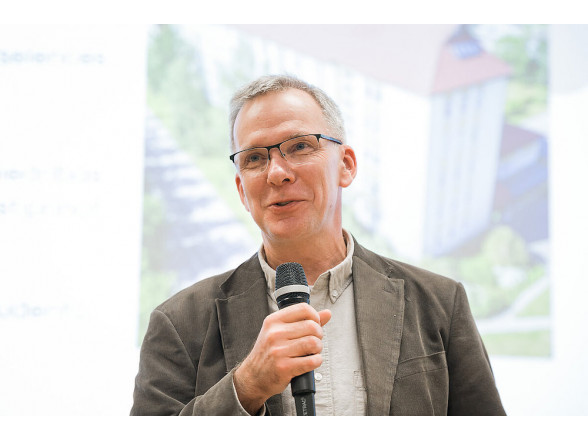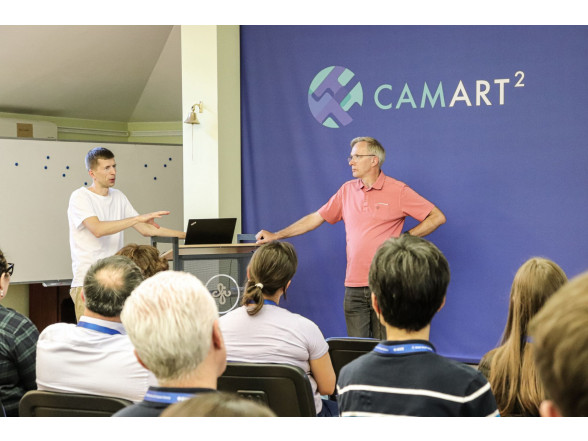On April 12, Labs of Latvia, a startup community platform providing information from and about the Latvian startup scene to the world, published an article in which the director of the ISSP UL, Dr.phys. Andris Anspoks talks about the readiness of the ISSP UL to fabricate nanoscale structures for quantum devices, the importance of joint research projects, the Latvian education system, and the future of Latvia.
The active elements of quantum devices can usually only be seen in an electron beam microscope; the precision must be in molecular size. Scientists at the ISSP UL’s Nanotechnology Center can make the nano-sized structures needed to fabricate quantum electronic and photonic devices.
The director of the ISSP UL, Andris Anspoks, explains that even the simplest transistor, photosensor and laser used in photo and video cameras, or laser meters are based on effects determined by quantum physics. It is quite interesting that some quantum technologies have been around for a long time, but translating them into products took a long time.
One example of a quantum device is the frequency comb developed by the ISSP UL, the Institute of Atomic Physics and Spectroscopy of the University of Latvia (IAPS UL) and Riga Technical University (RTU). Such a frequency comb aims to achieve faster optical communications and more sensitive sensors. "Another example we are working on is an optical transistor that would significantly increase data transmission speeds. This could be a revolution in data transmission," A. Anspoks clarifies.
The ISSP UL is one of the members of the Latvian Quantum Initiative. This initiative was born from the realization that there are excellent tools, and it was necessary to concentrate forces and attract additional people.
The ISSP UL director emphasizes that in quantum technologies, one can only do something with others because science is international. That is why consortia are established – to bring together the best. He explains that, for example, ISSP UL knows how to work with non-linear optics, but other partners have opportunities to measure record-breaking data transmission parameters. Therefore, in cooperation with RTU and the IAPS UL, the ISSP UL researchers work with photonics devices. In a consortium with the Institute of Chemical Physics, several research groups are engaged in developing various electronic devices.
- Anspoks is convinced that the Latvian Quantum Initiative will fundamentally change the lives of those involved and bring Latvian science closer to how research is conducted in Northern Europe. As he sees it, one of the main benefits is the ability to collaborate and focus on the task at hand, as the challenges on the front line of modern science are beyond the capacity of a single organization.
In parallel with the Latvian Quantum Initiative, researchers are also working on the Innovation Fund project, closely related to quantum technologies. Anspoks explains that in this project, among many other things, researchers are developing traditional photonics. Still, even here, it isn’t easy to draw the line between quantum and non-quantum technologies. For example, quantum combs, light sources and detectors, and nonlinear optical materials are needed for quantum devices and photonics. Therefore, having synergistic projects is beneficial.
Asked about how Latvia’s education system keeps up with the country’s quantum technologies development goals, A. Anspoks says there is always room for improvement. Still, overall, the situation is relatively good. However, he is concerned that Latvia invests more in education than the average in other EU countries, but the results are not so good compared to neighboring Estonia and Finland. "This is particularly evident when comparing the proportion of the ablest pupils in Latvia with the average in OECD countries, Estonia, and Finland. Latvia is significantly behind, although the average results look acceptable. This is a national problem, where one of the factors is the age structure of teachers affecting their competencies and the fragmented school network.
The ISSP UL director is most concerned about the low number of students, especially in physics, chemistry, and material sciences. He specifies that it is unacceptable to have a situation where the physics graduates of one academic year can be counted on both hands’ fingers. Latvia has smart people, but the education system should produce even more. The short- and medium-term solution for science and engineering programmes is to attract international students. RTU has made a good start in doing this. The state should help attract the best students from abroad and make local students understand that it is good to study in Latvia because the average British university is not significantly better than the University of Latvia, RTU or Riga Stradinš University.
Andris Anspoks says that science has several tasks. The most important is to create smart people because industry can only do with them. He emphasizes that if Latvia does not invest in science now, in 10 years, there will be no new technologies, and the country will lag significantly. Anspoks considers that to stay on the wave of science and technology, we must try to stay on this wave because only with science Latvia has a future.



